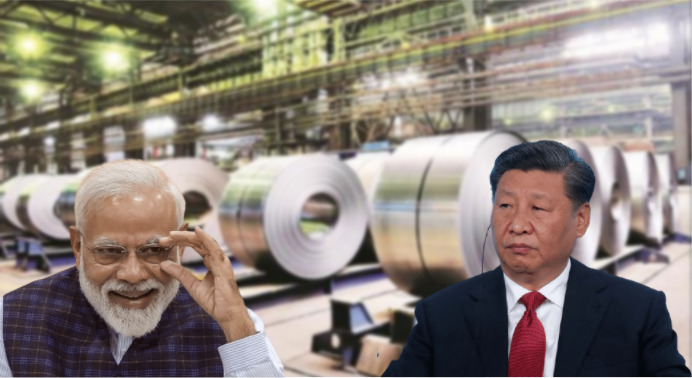As China continues to reel under a crippling power crisis, aided by the high scarcity of ‘Coal’ — its steel and chemical factories are staring at a bleak future as well. While China has dug the hole for itself and its industries, it is India, that is set to benefit from the opportunity
The power crisis in China has impacted global coal prices and logistics costs and increased raw material costs across sectors. Moreover, in the last few months, China has been suffering a coal crisis.
The steel industry has been clamped down in China. The Xi Jinping regime is likely to cut its steel output in the second half of this fiscal as well. Thus, the fall in China’s steel output and India’s imports of intermediate steel products would benefit Indian steel players
India Ratings and Research (Ind-Ra), a Fitch Group company stated that the situation was ripe for Indian steel companies to fill the void, both in domestic as well as international markets, “China’s energy crisis and the resultant likelihood of shutting down of Chinese companies or intermittent curbs on manufacturing would prove advantageous to Indian companies, as the demand for their products is bound to rise in both the domestic and international markets,”
Furthermore, the rating agency opined that domestic end-user industries for chemicals such as dyes and pigments, pharmaceuticals and agrochemicals will pass on the overall increase in costs to consumers, thus maintaining profitability.
What is happening in China?
China is the biggest coal consumer in the world. The Communist nation still consumes over 56 per cent of coal as a part of its total energy consumption. The fossil fuel is the most vital part of China’s energy security. Such a high concentration of thermal power in China means that any decline in coal supply hurts its ability to generate sufficient electricity. Presently, China is facing a serious shortfall of Australian coal.
Last year, Beijing imposed an unofficial ban on Australian coal that immediately led to Southern provinces in the Communist country going dark. Moreover, as a direct repercussion of the scarcity of non-renewable material, China has been forced to shut down everything from aluminium smelters to textiles, and even food processing units like soybean plants.
Read More: China is shutting down Aluminium, Textile and many more industries
How big is China’s energy deficit?
To worsen Beijing’s woes, the three main industrial Chinese provinces- Jiangsu, Zhejiang and Guangdong that account for around a third of the economy of China, are facing power (electricity) cuts. Similarly, in Zhejiang, 160 industrial units including textile units had to be shut down.
With China’s industries failing, we are looking at a huge socio-economic crisis in the country, where it will fail to fulfil all its basic needs from manufacturing basic industrial goods to producing consumer goods like textiles and supplying enough electricity to power and illuminate its households.
Other sectors of India that might be benefitted
As reported by TFI, after India emerged as one of the preferred destinations of foreign companies leaving the Chinese shores in the aftermath of the Covid pandemic, the Indian textile sector is also looking to benefit from the economic downturn and power crisis in China.
China — a major exporter of apparel and textiles to the world is seeing its market shrink, and India, the emerging textile hub is set to replace it fair and square. Textile is among the sectors for which Indian products have been known internationally for decades. Indian exports used to rule over the western textile markets for centuries but in the late 19th and 20th centuries, the prowess diminished with the rise of synthetic fibres.
Read More: As China reels under massive power-cuts, Piyush Goyal is all set to turn India into a textile giant
The opportunity to pin down the Chinese textile industry could not have come at a more opportune time. The Narendra Modi government last month (September 8) extended the ambit of the revolutionary Production Linked Incentive (PLI) scheme and included the Textiles sector in it.
India has a golden opportunity to give a massive fillip to some of its most economically profitable industries. The onus is now on companies to seize the initiative and go for the kill.
